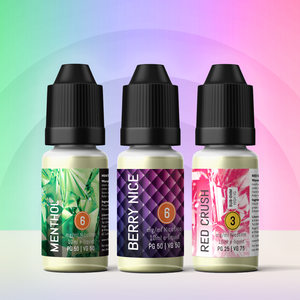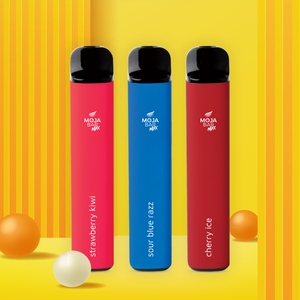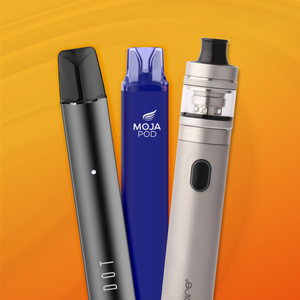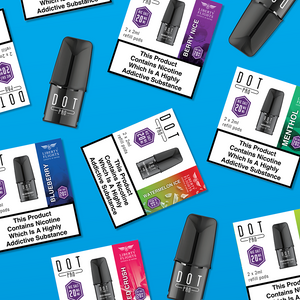
How do e-cigarettes satisfy my nicotine craving vs. traditional cigarettes?
Accurately estimating the cost and other benefits from switching to e-cigarettes can be challenging and requires a good understanding of the vast differences between e-cigarettes and traditional cigarettes. Therefore, the objective of this blog is to discuss these key differences to help you more accurately predict the cost savings and other benefits from initially switching to e-cigarettes and throughout each stage of your vaping journey.
Nicotine Absorption
The amount of nicotine present in your blood after consuming nicotine is referred to as nicotine absorption.1-3 Given the variety of brands and sizes, a single traditional cigarette or alternative nicotine-containing products can significantly vary in nicotine content.4 In addition, nicotine consumers are not only interested in the amount of nicotine absorbed but also how fast you feel its effects. The manner of which you take in nicotine (e.g. smoking, nicotine gum) will significantly influence this rate.5 Cigarettes have been around since the early 1800s and consequently they are thoroughly studied and well understood. In contrast, there are only a limited amount of investigations on nicotine absorption from e-cigarettes to date and even fewer studies that compare the difference in absorption between e-cigarettes and cigarettes.5-10
Hajak et al. evaluated the nicotine absorption from 6 individuals using a 1st generation device that contained 2.4% (w/v) nicotine. The authors concluded that the absorption from e-cigarettes was faster than nicotine replacement gum and nasal spray but slower than conventional cigarettes and state that in order to compete with cigarettes, the nicotine dose should increase. However, this does not mean that you should start off vaping >2.4% (w/v) because nicotine absorption will also depend on your experience with vaping and selected device.5
Vaping experience
The authors from the study described above evaluated the nicotine absorption following a first time user experience and after 1 month of vaping. Results showed a 24% increase in nicotine concentration and a 79% increase in overall nicotine intake after 4 weeks of vaping experience.5 This increase over time can be attributed to the users “adjusting” to the puff differences between smoking and vaping.6
A study evaluating vaping patterns, observed that experienced vapers take a longer puff compared to cigarette smokers vaping for the first time.6 This was explained by the fact that smokers are used to inhaling an already burning cigarette, while vapers produce an aerosol only at the time of activation. Consequently, vapers will compensate for this by taking longer puffs. Another important consideration is the difference in puff strength. Smokers will draw harder puffs in order to produce more smoke but this has no effect on aerosol production when vaping.6 In a follow-up study, the authors took these findings a step further and evaluated differences in nicotine absorption between experienced vapers and first-time users (Figure 1).7

Figure 1. Average nicotine plasma concentration vs. time profiles for n=24 experienced vapers and n=23 first-time vapers (cigarette smokers).7
Figure 1 shows the average nicotine plasma concentration vs. time profiles for experienced and first-time study participants using the same device and e-liquid containing 1.8% (w/v) nicotine. While no statistical differences were observed at the start of the experiment (8 hours of nicotine abstinence), the data illustrate a significant difference in nicotine absorption for all following time points. Unfortunately, the variability within each group is not shown in Figure 1. Overall, the results indicate that first-time users are unable to obtain similar nicotine levels as experienced vapors even when using the same device.
Device Performance
Using a 1.8 % (w/v) e-liquid, Farsalinos et al. compared the nicotine absorption from a 1st and 2rd generation device with experienced e-cigarette users. The authors report a 35–72% higher nicotine concentration when using the 2rd generation compared to the 1st generation device.8 In a more recent study by St. Helen et al., the authors measured the nicotine plasma concentration of experienced vapers using their device and e-liquid of choice.9 The authors report that average nicotine concentrations from e-cigarettes were lower than average levels from cigarettes, but within the range of many smokers. The authors also report variability between vapers, which is not unexpected but the range of device types used in this study adds to the complexity of results interpretation. Figure 2 shows the results from 3 individuals and Table 1 lists the nicotine concentration vaped and device generation used. As shown in Figure 2, participant 7 obtained the highest nicotine blood concentration up to 15 min followed by a similar concentration to participant 2 after 30 min. As listed in Table 1, participant 7 selected a 2nd generation device but vaped the lowest concentration e-liquid. Participant 1 (also used a 2nd generation device) resulted in the lowest concentration of the three but vaped the highest e-liquid concentration of 2.4% (w/v). These observations from Farsalinos et al., clearly illustrate the influence of the device type (and not only generation) on nicotine delivery efficiency.8,9

Figure 2. Nicotine plasma concentration vs. time profiles of 3 participants.9

Table 1. Participants’ usual e-cigarette and e-liquid used in the study. Adapted from Tables 1 and 2 of reference 9.
Conclusion
E-cigarette popularity is attributed to their ability to satisfy nicotine cravings more efficiently than other nicotine replacement therapies.5,9 Moreover, they also mimic the behavioral addiction more so than any other nicotine replacement product. The wide variety of devices is an attraction for experienced e-cigarette users but can be intimidating to a novice. If you are completely new to vaping, it is extremely important to take the time to learn about their various features and how to properly care for them. Liberty Flights recommends using a 2nd generation device to begin your vaping journey but encourages you to adapt your puffing style to maximise the nicotine intake from e-cigarettes. Initially, you may need to take more puffs throughout the day to satisfy the nicotine craving you get from cigarettes. It’s important to keep in mind that smoking a cigarette has a beginning and end whereas you will most likely vape throughout the day. Another advantage with vaping is that you can do it in most areas where smoking is prohibited. As you adapt your puffing style and learn more about the hardware, you can start customising to suit your preferences. Examples of these include decreasing your e-liquid nicotine concentration, selecting a more sophisticated device and/or experiment with different flavours and/or base ratios.
How much money will I save by switching to e-cigarettes?
We’ll answer this based on the assumptions that the nicotine absorption from an EVOD2 is similar to smoking a cigarette and that the puffing styles do not influence nicotine absorption:

Cigarettes: 1 pack of standard cigarettes = £8.50. If you smoke 1 pack per day then that comes out to £3102.50 per year. The cost of lighters, matches and/or ashtrays is assumed to be ~ £30/year.
Total cost = £3132.50/year
Taste Kit: Includes EVOD2 clearomizer, eGo 900 mA/h battery, charger, and 10 ml 1.8% (w/v) XO e-liquid = £24.99 for initial set-up costs. We estimate the running costs as follows:
E-liquid:
The average vaper consumes approximately 3 ml/day = 1095 ml of e-liquid/year. A 10 ml Liberty Flights XO bottle = £4.85, therefore you will purchase ~ 108 bottles/year (in addition to the 10 ml included in the starter kit). £4.85 * 108 bottles = £523.80/year
Atomisers running costs:
Atomiser last on average 2.5 weeks, therefore you will need to purchase ~ 20 atomisers/year. A 10 pack of Kanger Dual Heads = £19.98 * 2 = £39.96.
Total e-cigarette cost = £588.75/year
Total savings of £2,543.75/year
Monica Vialpando
Chief Scientific Officer
References
- Kalowski et al. Filter ventilation and nicotine content of tobacco in cigarettes form Canada, the United Kingdom, and the United States. (1998) Tob Control 7:369-3751998)
- Benowitz and Jacob (1984) Daily intake of nicotine during cigarette smoking. Clin Pharmacol Ther 35:499-504.
- Ling and Parry (1949) The amount of nicotine absorbed in smoking. Brit J Pharmacol 4:313-314.
- Digard et al. (2012) Determination of nicotine absorption from multiple tobacco products and nicotine gum. Nic Tob Res doi: 10.1093/ntr/nts123
- Hajak et al. (2015) Nicotine intake from electronic cigarettes on initial use and after 4 weks of regular use. Nic Tob Res 17:175-179.
- Farsalinos et al. (2013) Evaluation of electronic cigarette use (vaping) topography and estimation of liquid consumption: implications for research protocol standards definition and for public health authorities’ regulation. Int J Environ Res Public Health 10:2500-2514.
- Farsalinos et al. (2015) Nicotine absorption from electronic cigarette use: comparison between experienced consumers (vapers) and naÏve users (smokers). Sci Rep 17:11269
- Farsalinos et al. (2014) Nicotine absorption from electronic cigarette use: comparison between first and new-generation devices. Nature Sci Reports doi: 10.1038/srep0413
- St. Helen et al. (2015) Nicotine delivery, retention, and pharmacokinetics from various electronic cigarettes. Addiction doi: 10.1111/add.13183
- Dawkins and Corcoran (2014) Acute electronic cigarette use: nicotine delivery and subjective effects in regular users. Psychopharmacology 231:401-407









